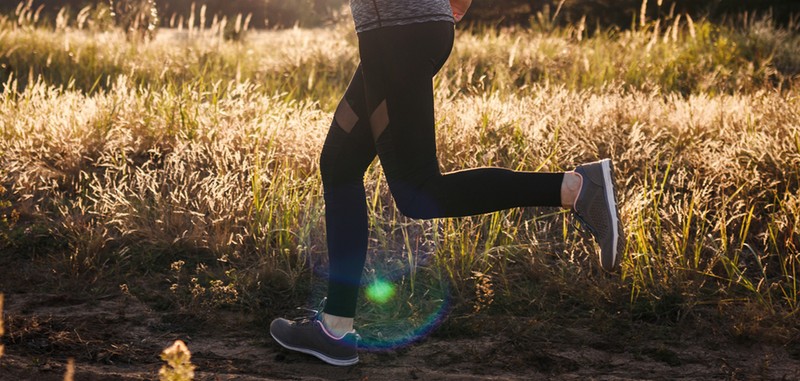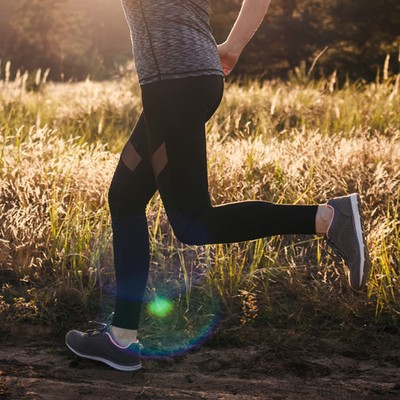

A Beginner’s Guide To Running
Understand It’s Never Too Late
“You have two ages when it comes to running. First, you have your running age, and then you have your chronological age. Someone in their sixties who has been running since they were 30 actually has more of a chance of injury, and aches and pains as opposed to someone starting completely from scratch later in life. You’ll also see real improvement in the long term. Remember there are many benefits to running apart from feeling fitter and having more energy.” – Nick Anderson, Polar running coach
Know The Benefits
“Running later in life is a fantastic way to maintain muscle tone whilst also improving cardiovascular health. It also boosts metabolism and increases levels of your ‘good’ cholesterol, both of which can reduce the risk of heart disease. Studies also show running can lower the risk of certain cancers, lower the odds of diabetes and control inflammation. It will give your mental health a boost, too. Running can lead to fewer feelings of depression and anxiety as, when you run, your body releases endorphins which produce the iconic ‘runner’s high’, a short-lasting, deeply euphoric state that can follow intense exercise.” – Carlos Cobiella, consultant orthopaedic surgeon
Start By Seeing A Physio
“If you were going to take your car on a long journey, it would be wise to get it serviced beforehand. The same goes for running – book in with a physio to find out areas of weakness, areas of strength and things you may need to work on. There will probably be some areas where you’ll need to think about improving your mobility, too.” – Nick
Think About Chatting To Your GP, Too
“Be honest about your health – you don’t want old injuries to flare, so know your limitations and consider that walking may be better and safer at first. If you have had joint or movement problems in the past, chat to your GP to ensure you’re in good form. This is especially important if you live a sedentary lifestyle, are overweight or have an office-based job.” – Carlos
Buy A Decent Pair Of Trainers
“Trainers matter whatever your age, but are even more important if you’re older as you need to ensure stability, especially if you’re a beginner. Book in for a gait analysis at your local running shop – they will ask you to run on a treadmill and assess how you run. From there, they’ll look at your gait to determine what type of trainer you need. You may need more cushioning, you may have a higher arch in your foot or, if you have a flatter foot, you may need more stability. Trainers are very important – they’ll help you run more efficiently and you’re less likely to get injured.” – Nick
Don’t Forget About Strength Training
“If you’re starting later in life, a solid strength and conditioning programme alongside your running programme will prevent injury, make you a better runner and even help with recovery. If you can lift weights, great, but cross-training such as swimming or rowing are also beneficial and will help you build a balanced plan to enable progress. Your legs take a lot of pressure and stress when you’re hitting the tarmac, so the stronger they are, the better. Exercises like lunges and squats are great, adding in hand weights as you progress, as are the leg standing poses in yoga.” – Nick
Be Brave
“The most common thing we hear from our mature clients is that they’re rubbish at running or they used to be a runner but can’t run anymore. The truth is, so long as you can still use your legs, the likelihood is that you can run. Running is one of those things that requires little skill, a lot of patience and a moderate amount of bravery. Another important thing to remember is that nobody is looking at you when you run. So, remind yourself that you’re doing this for you and that no-one cares about what you look like. Plus, there’s no such thing as a bad runner, and you don’t have to run every day. In fact, having a varied exercise routine that includes both strength training and mobility will aid your running.” – Hannah Lanel, founder of The Fore
Always Warm Up
“Running is typically associated with leg, knee and foot pain, but runners can also experience upper body discomfort in the neck and shoulders. Most upper body pain related to running is caused by poor form or too much tension, which can trigger neck and shoulder pain. For example, hunched or rounded shoulders combined with swinging your arms too wide can trigger pain. Remember that subtle movements when you run may seem harmless, but these repetitive actions over time can cause muscle spasms, a stiff neck, tense muscles and even a rotator cuff injury. A few gentle yoga stretches before a run is a great way to warm up.” – Carlos
Start With 20 Minutes
“For your very first run, aim for 20 minutes, with roughly even splits of running and walking – 90 seconds of walking followed by 90 seconds of running is a good place to start. As you improve, you can increase the total duration, or run for longer. After a few weeks, you should be able to increase both simultaneously. If in doubt, download the Couch to 5k app, which will guide you through each session over the weeks. If you run consistently three times a week, you’ll see improvements in two weeks. You will be able to run further, for longer, with less discomfort and without feeling so breathless.” – Lewis Moses, INCUS Performance running advisor and lead coach at New Levels Coaching
Go Slowly
“Be slow and patient – you should be able to run and chat at the same time. In the early weeks, if you can’t talk the entire time you’re jogging, you’re running too hard. If you can find an easy pace at which you feel comfortable and strong, you’ll ultimately see bigger fitness gains and fewer injuries. As the weeks go by, you can start to include some blocks of running at a slightly faster pace – think 30 second bursts of increasing the pace slightly – which would ideally be done under control but with a slight element of discomfort. Several weeks into your journey, you’ll be able to push that little bit harder. After six to eight weeks, you may be able to run a 5k continuously, but be careful of the ‘terrible toos’ – don’t do too much, too far, too soon and too often. Slow and steady wins the race.” – Nick
Ditch The Treadmill
“It’s a common misconception that pounding the pavement is bad for your bones and joints. In fact, the latest research shows it’s actually beneficial for your bones, as running on concrete and tarmac creates high ground reaction forces that actively strengthen bones. Running on a traditional treadmill may feel like there’s less impact on the body, but it physically isn’t the same. Outdoor running works your smaller, stabiliser muscles that treadmill running may not engage – the muscle activation is completely different. Plus, when you run outside, you actively have to push yourself forwards using the backs of your legs, whereas on a treadmill the belt pulls you forward, so you end up using less of your hamstring muscles and your quads do most of the work. If you always run on a treadmill, this could lead to an overuse injury and, if you do suddenly run outside, your muscles may not be strong enough, which could also lead to an injury.” – Hannah
Think About Form
“Imagine a balloon on a string attached to your chest which you move forward as you run. The ideal running posture involves an elongated spine, relaxed pelvis, arms bent at 90 degrees to your torso with your body leaning slightly forward.” – Carlos
Don’t Give Up
“Physiologically, it takes two weeks to see improvements. In the early stages, you’ll notice immediate improvements in energy levels and mood, but the real fitness gains will come a couple of weeks after the run you’ve done. After three or four weeks, you may reach a plateau, which is completely normal. If this happens, consider factoring in a couple of extra easy days or an easier week before pushing on. Build it up in stages and be patient.” – Nick
Factor In Recovery
“The recovery process is just as important as the running itself. Essentially, the sooner you rehydrate and eat, the better your recovery will be. Aim for a balance of carbohydrates and protein to replace glycogen and aid muscle recovery, ideally within an hour of a workout. Nut butter on wholewheat toast, Greek yoghurt with a nutty, low-sugar granola, or brown rice with salmon or chicken are great options to kickstart the recovery process.” - Nick
For more information, visit Polar.com, INCUSPerformance.com, The-Fore.co.uk and TheShoulderPractice.com.
DISCLAIMER: Features published by SheerLuxe are not intended to treat, diagnose, cure or prevent any disease. Always seek the advice of your GP or another qualified healthcare provider for any questions you have regarding a medical condition, and before undertaking any diet, exercise or other health-related programme.
DISCLAIMER: We endeavour to always credit the correct original source of every image we use. If you think a credit may be incorrect, please contact us at info@sheerluxe.com.

